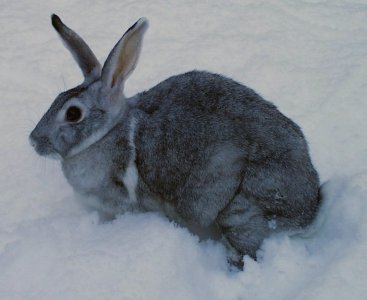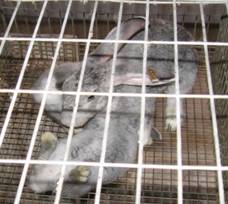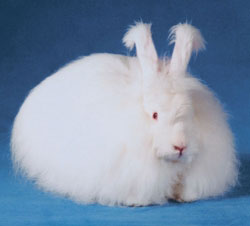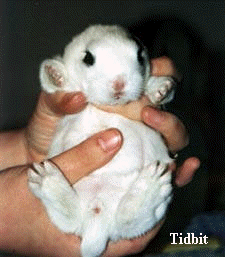General Information
Rabbits are basically reared for meat, fur and wool. They have great potential to convert the absolute feed into quality products for human beings.
Advantages of rabbit for farming are:
-
Rabbits can be fed with high forage, low grain diet that is largely non-competitive with human food.
-
Rabbits have high feed conversion efficiency with feed/grain rations (2.5-3.0 on high grain diet and 3.5-4.0 on high forage, grain free diet).
-
They have a high growth rate attaining market weight of about 2 kg at 12 weeks of age.
-
Rabbits have the potential of being in a constant state of reproduction. They can be crossed within 24 hours of kindling, during post-partum heat.
-
Rabbit meat is a highly nutritious, tasty and excellent in quality. Meat is rich in protein, low in fat, cholesterol and sodium. Thus, can be recommended for cardiac patients.
-
Rabbits are suited to both small scale (backyard) and large-scale commercial production.
-
Rabbit is also utilized for show and exhibition purposes
Breeds
Breed and description of rabbits available in India
| Breeds |
Description |
| Soviet Chinchilla |
This breed was evolved in erstwhile USSR. Adults weigh 4.5 to 5 kg. Though this breed is reared for meat its fur is a fancy in fur crafts. |
| Grey Giant |
This breed is also a native of erstwhile USSR. Adults weigh 4.5 to 5 kg. Due to the resemblance of its fur with that of hare, it is often mistaken as hare. It is also reared for meat and fur skin. |
| Newzealand White |
This breed was evolved in England. Fur is white and skin is albino. The eye colour is red due to the absence of melanin pigment. Adult weight is 4.5 to 5 kg. Meat and furskin are the main products. |
| White Giant |
White Giant also originated in the erstwhile Soviet Union. It is almost similar in appearance to Newzealand White. Colour of the fur is white while that of the eyes and skin is red. The length of hind limbs as well as body size is larger than that of New Zealand White. |
| Angora |
Angora is a very ancient breed of small rabbit weighing around 3 kilograms. It is a wool type rabbit with white fur. Annual wool yield recorded is between 300-1000g in 3 to 4 clippings. |
| Cross-breds |
The crosses between the above mentioned breeds and local types have been produced. They are found to be highly adaptive to Kerala conditions. The adult weighs 4 to 4.5 kg and breeds all through the year. Colour of fur is not uniform. |
Rabbit breeds

Soviet Chinchilla |

Giant Grey |

Angora |
Economic traits in rabbits used for selection
The traits of rabbit, which are instrumental in giving financial benefits to the farmer, are called as economic traits of rabbits. The performance of rabbits in these traits is the basis for selection of breeding animals. These traits are:
Litter size at birth
All the young ones of a kindling constitute a litter. Litter size at birth for the doe is one of the characters which contributes for the economic returns from rabbit rearing. The optimum value should be eight. Some of the kits will be born dead and that should be considered. Average birth weight of kits. Usually birth weight of kits will be less, if number of kits in the litter is more and vice-versa. For survivability of the kits, it should have atleast 40 g body weight at the time of birth. Average birth weight of kits of a litter in broiler rabbits should be 40-50 g or more.
Litter weight at 21-day age (three weeks)
The young kits depend fully on their mother for first 10-12 days of their life. At this time their eyes are not open and the sole feed is mother’s milk. If the doe is good in it’s mothering ability the survivability and growth of bunnies will be more. The litter weight at three weeks age is taken as criteria for measurement of mothering ability of the doe. The optimum value for litter weight at 21 days age is 1.2 - 1.5 kg.
Litter size at 21 days
This trait is also equally important in measuring the mothering ability of doe. The does selected for breeding must have atleast six bunnies in the litter at 21st day.
Weaning weight of litter
The young bunnies are weaned between 30 days and 45 days. The weaning weight of the litter is an important selection criteria. At the time of weaning the body weight of bunnies should be more than 450 gm. Litter weight at weaning must be more than 3 kg.
Litter size at weaning
Atleast 5-6 bunnies should be available from each litter at the time of weaning. More number of weaned bunnies are always advantageous for the farmer.
Number of kindling’s per year per doe
The gestation period of does is thirty days. Number of kindling’s from a doe per year depends on many factors like weaning age, time of maturing, etc. Under our conditions it is advisable to breed the does within a week of weaning. So if weaning is practiced at thirty days, there should be five litters for weaning from each breeding doe.
Number of weaned bunnies per year per doe. This is another economically important trait. If five to six bunnies are available for weaning from each litter and if five litters are produced by the doe per year, the number of weaned bunnies from the doe per year should be 25.
Feed conversion efficiency
The basic principle of broiler rabbit industry is to exploit the feed efficiency of broiler rabbits. It is practically impossible to record daily the feed given to each and every rabbit. Hence the number of days taken to attain 2 kg body weight is taken as a yardstick for feed conversion efficiency. Animals who attain 2 kg body weight at lower age are assumed to be better converters of feed and are selected as breeding animal.
Handling
The rabbits should always be handled firmly but gently. A rabbit should be picked up by a firm grip on the loose skin over the scruff of the neck with one hand and the other hand supporting the hindquarters. Young rabbits can be lifted by grasping them firmly over the loins, the fingers on one side and thumb on the other.

Sexing
Sexing is usually done at weaning along with tattooing. When the vent area is gently pressed the female will show a slit like aperture and a male will show slightly raised cylindrical round tip.
Coprophagy
Rabbits void, apart from the normal dark green hard faecal pellets, soft green faecal pellets (Cecotrophs) in the dawn hours, which have a high content of nitrogen and B - complex vitamins. Cecotrophs produced in the caecum are ingested directly from the anus without mastication. These faecal pellets contain nearly three times the amount of protein than hard faecal pellets.
Slaughter
The two most common methods are (a) dislocation of the neck, and (b) stunning followed by severing the neck to ensure satisfactory bleeding. The second method may also be used in conjunction with the dislocation technique.
( source: www.vuatkerala.org ) |